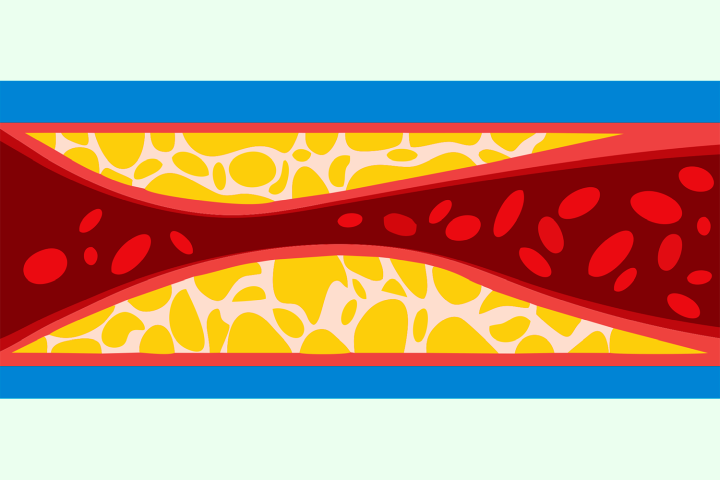To provide services at the highest level, we use cookies. Using the website requires you to choose settings related to their storage on your device. If you want to know what each type of cookie is used for, click the Details button below.
Atherosclerosis – causes, effects, treatment15 stycznia 2023 |

Atherosclerosis is a disease characterized by the accumulation of fat and other substances in the walls of blood vessels. This leads to the narrowing of these vessels and changes in their structure, which can result in serious health problems such as heart attack or stroke. In this article, we will present several effective treatments for atherosclerosis.
Therefore, it is important to control the level of cholesterol in the blood. LDL cholesterol, also known as bad cholesterol, is the main cause of the formation of atherosclerotic plaques in blood vessels. Preventing the deposition of cholesterol through healthy eating and regular physical activity is essential. In some cases, the doctor may also prescribe medications to lower cholesterol levels, particularly statins.
Another important element of treatment for atherosclerosis is blood pressure control. Hypertension, or high blood pressure, can lead to damage to the blood vessels, which in turn accelerates the process of atherosclerotic plaque formation. The doctor may recommend appropriate medications or changes in diet and lifestyle to lower blood pressure.
Regular physical activity also remains a significant element of treatment for atherosclerosis. Aerobic exercises such as jogging, swimming, or cycling can help lower cholesterol levels in the blood and strengthen the heart and cardiovascular system. However, it is important to consult with a doctor before starting an exercise program.
In some cases, the use of blood-thinning medications may be necessary. These medications help prevent the formation of blood clots that can cause serious health problems such as heart attack or stroke. However, effective treatment of atherosclerosis requires taking a range of actions.
Controlling cholesterol and blood pressure levels, engaging in regular physical activity, and using medications can help prevent serious complications associated with this disease. It is important to remember that the best way to avoid atherosclerosis is to prevent its development through a healthy lifestyle and regular check-ups with a doctor.
Atherosclerosis is a disease characterized by the calcification and narrowing of arteries. This disease affects many people worldwide and can lead to complications such as heart attack or stroke. There are certain steps that can be taken to prevent atherosclerosis or significantly minimize its effects.
The first step in preventing atherosclerosis is a healthy lifestyle. It is important to engage in regular physical activity, avoid smoking, and limit the consumption of alcohol. Additionally, a healthy and balanced diet rich in vegetables, fruits, whole grains, and low-fat sources of protein can help reduce the risk of cardiovascular diseases, including atherosclerosis.
Another step is controlling blood pressure and cholesterol levels. High blood pressure and high cholesterol levels are two major risk factors for atherosclerosis. There are various methods to lower blood pressure and cholesterol levels, including medications and lifestyle and dietary changes. Regular blood tests and visits to the doctor can help monitor these values.
Stress is also a risk factor for atherosclerosis. It is associated with an unhealthy lifestyle that includes lack of physical activity, excessive alcohol consumption, and smoking. Therefore, it is important to find ways to reduce stress, such as meditation, yoga, or breathing exercises.
The last but not least step in preventing atherosclerosis is regular health check-ups with a doctor. This includes blood tests as well as blood pressure measurement and imaging tests of the heart and blood vessels, which can help detect cardiovascular diseases at an early stage and enable the implementation of appropriate treatments and minimizing the consequences of the disease.
Initially, atherosclerosis does not cause any symptoms. However, as the disease progresses, circulation problems, chest pain, or shortness of breath may occur. Therefore, it is important to always undergo necessary preventive screenings.
Yes. The risk of developing atherosclerosis can be significantly reduced by making lifestyle changes. It is worth adopting a healthy diet, engaging in regular physical activity, and ensuring proper sleep hygiene. By doing so, the risk of developing atherosclerosis will be lower.
The risk factors for atherosclerosis include high blood pressure, diabetes, smoking, and high cholesterol levels in the blood. By eliminating these factors, the risk of atherosclerosis is greatly reduced.
The diagnosis of atherosclerosis is based on blood tests, primarily cholesterol levels in the blood. Other tests that may be performed include an electrocardiogram (ECG), ultrasound with Doppler, and electroencephalogram (EEG).
Atherosclerosis has a multifactorial nature and is usually not directly inherited. However, certain genetic factors can increase the risk. In particular, individuals who have inherited a tendency to have high cholesterol levels in the blood are more prone to atherosclerosis.